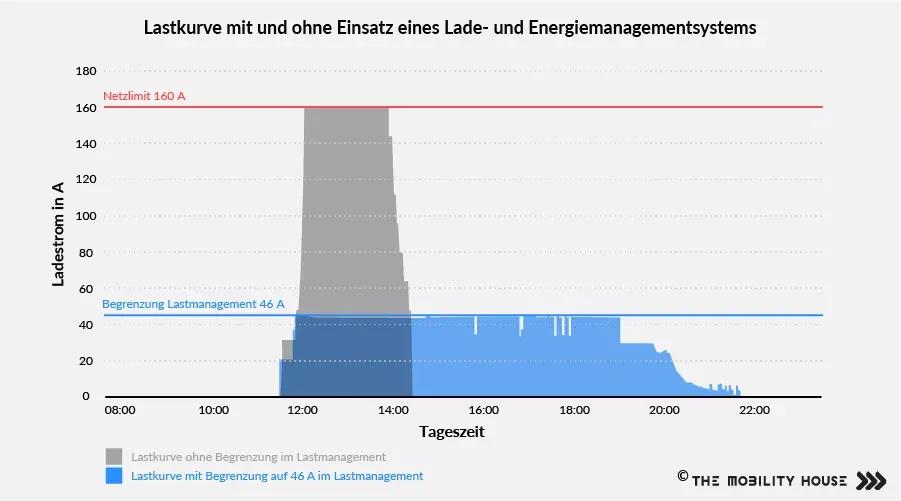The VDE (German Association for Electrical, Electronic & Information Technologies) and VDI (The Association of German Engineers) have specified technical and regulatory requirements for these charging facilities. These requirements are relevant not only for the owners themselves but also for the electricians and building managers who are commissioned with installing them. The Mobility House explains what role the simultaneity factor plays in the installation of charging stations and how it can be reduced by intelligent load management.
What is the simultaneity factor?
The simultaneity factor represents how many electric consumers are operated with full power in one household or power circuit at the same time. It can therefore be used to make decisions regarding the total connected load that needs to be planned for.
When planning high-power charging parks on highways, for example, there are very few ways to reduce the simultaneity factor: the users expect maximum charging power to keep their charging times to a minimum—even when all stations are being used at the same time. On the other hand, if a large fleet of company cars are charged on the company premises, the simultaneity factor can be reduced down to roughly 0.2—without any restrictions for the users. This is because the vehicles are parked for a long time and each vehicle on average requires relatively little energy.
Reducing the simultaneity factor with load management
Using intelligent load management - for example with our Charging and Energy Management system ChargePilot® - can in most cases lead to a reduction in the simultaneity factor. Load management is recommended particularly at sites with multiple users, such as the underground garage of an apartment block, in order to avoid the unnecessary costs of excessive mains connection capacity and electric installation.
With the short, local communication chain between car, charging station, and controller, the charging process is adjusted in less than ten seconds. This means that load management can enable a lower simultaneity factor and ensure that the available power is not exceeded. In addition to keeping the available total charging power constant, it is also possible to adjust the power to suit external requirements. A measuring transformer at the mains connection point can measure the electricity that is being drawn by the site as a whole and adjust the available charging power accordingly. For example, the charging power for vehicles in a logistics center can be significantly reduced when the conveyor belts and sorting systems are running. When they are not in use, much more power can be made available for charging. Alternatively, it is possible to follow the specifications of the building's energy management system.
Communication between charging stations and charging and energy management system
For the billing, management, and remote monitoring of the charging infrastructure, the Guideline VDI 2166 Sheet 2 on planning electric systems in buildings recommends connecting the charging stations to an appropriate data communication system. The charging and energy management system can then—as in the case of the on standard interfaces based ChargePilot®—communicate with the charging stations via the communication protocol OCPP (Open Charge Point Protocol). The charging infrastructure is equipped with a LAN interface for this purpose.
Advantages of reducing the simultaneity factor
Reducing the simultaneity factor can generate considerable cost savings. Both the expansion of the mains connection and an increase in power charges can be avoided. This will be explained in more detail with the following example: a package delivery service has 30 electric vehicles, each with 11 kW charging power. If they are charged at the same time in the evening, a 180 kW expansion would be needed. With ChargePilot®, the load would be distributed over the night and expansion would not be necessary. This would enable the company to avoid load peaks and save 47,000 euros [1] in the first year alone.
The decision as to what simultaneity factor should be aimed for when electric vehicles are charged by load management is based on the following parameters in particular:
- Maximum charging power of the vehicles
- Maximum charging power of the charging infrastructure
- Usage pattern of the charging infrastructure
- Number of charging stations
Simultaneity factor in real-life scenarios
In the following, real data from a charging park with ten charging stations will illustrate how ChargePilot® works and provide indications of the simultaneity factor. The scenario shows the load curves of a charging park with ten vehicles starting to charge in the space of one hour, with and without the use of ChargePilot. To make the charging process more efficient, charging is performed with a minimum current of 10 amperes in the real-life example.
In the scenario of the grey load curve, the vehicles are fully charged within roughly 2.5 hours around midday. The maximum current for a simultaneity factor of 1 is 160 amperes. In the scenario of the blue load curve, the vehicles are fully charged over the entire day. Reducing the simultaneity factor makes it possible to reduce the charging current to 46 amperes per phase.

What cost savings are possible?
In conclusion: As the above use case shows, with ChargePilot® it is possible to reduce the maximum current per phase by over 100 amperes and thus lower the simultaneity factor considerably, down to 0.28. In the example, this results in a savings potential of over 7,000 euros a year with complete fulfillment of mobility needs and all the requirements of the VDI guidelines.
[1] The savings were determined on the basis of empirical values as follows: Building cost subsidy and costs invoiced by the distribution network operator for the grid connection amounting to a one-time charge of 32,000 euros and a performance price of 15,000 euros per year.
